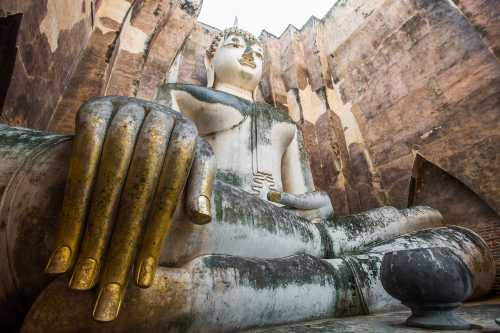#GetDiscountNotDependingOnLuck Wat Sri Chum is an ancient religious site located outside the northern city wall of Sukhothai Historical Park, Muang Kao Subdistrict, Mueang Sukhothai District, Sukhothai Province. This temple enshrines a large Buddha statue in the Mara-Vijaya posture called "Phra Atchana". The Buddha statue is enshrined in a pavilion, which has now collapsed, leaving only the surrounding walls, making it an outdoor Buddha statue to this day. The structure of Wat Sri Chum is more special than other temples in Sukhothai Historical Park because it does not have a main chedi, but is replaced by a pavilion enshrining a Buddha statue inside, which is located behind the main chapel. This temple is believed to have been built during the reign of King Ramkhamhaeng the Great, or around the 19th Buddhist century. It was first restored by the Fine Arts Department in 1953 and the pavilion area was restored again in 1967. Phra Phuttha Atchana is considered one of the most important tourist attractions and symbols of Sukhothai Historical Park. In addition, the area on the northern side of the pavilion also consists of a large wild mango tree that is more than 200 years old, with a height of more than 20 meters. It has been preserved and registered as a national heritage by the Ministry of Culture. "Wat Sri Chum" comes from the original local word meaning Bodhi tree. Therefore, the name Sri Chum means a grove of Bodhi trees. However, in the book of the Royal Chronicles of Ayutthaya written in the late Ayutthaya period, this meaning was not understood, so the place was called "Rishi Chum". Wat Sri Chum is assumed to have been built during the reign of King Ramkhamhaeng, as stated in the Sukhothai Inscription No. 1 that At the foot of the bed of Sukhothai city... there is Phra Achana, there is a castle. The principal Buddha image in the pavilion is therefore called "Phra Achana". The pavilion is 32 meters wide on each side, 15 meters high, and the walls are 3 meters thick. The left wall has a hole for a staircase. The wall leads to the roof. There are old paintings on the walls of the tunnel, but almost all of them are faded. This painting is almost 700 years old. The ceiling and walls have 50 slate slabs carved with lines depicting stories from various Jatakas, arranged continuously. All of these are considered to be the oldest Thai paintings. During the Ayutthaya period, when Somdet Phra Naresuan the Great declared independence in 2127 at the city of Kraeng, causing other cities to cancel their tributes to the Burmese, but there was still the city of Cheliang (Sawankhalok) that refused to comply with his royal command. So he led his army to conquer Cheliang and gathered his army at Wat Sri Chum before going to attack Cheliang. Since the battle was between Thais and other Thais, the soldiers were not motivated to fight. Somdet Phra Naresuan therefore planned to boost the soldiers’ morale by having one of his soldiers climb up the stairs behind the Buddha image and speak words of encouragement to them, which gave the soldiers the motivation to fight. As a result, the legend of the talking Buddha at Wat Sri Chum arose. Phra Naresuan also held the water-pouring ceremony to pledge allegiance at this temple. According to evidence, this temple was extensively renovated during the reign of King Lithai and has been continuously maintained. It is assumed that this temple was abandoned during the late Ayutthaya period until the reign of King Rama IX when a renovation project was launched in 1952. The restoration of the Phra Achana Buddha image was initiated by Professor Silpa Bhirasri and Professor Khian Yimsiri. As a result, the temple is in its current state. "Phra Achana" The word Achana has been interpreted as referring to the Pali word "Ajala", which means "one who is unshakable, steadfast", "one who is worthy of respect and worship". Phra Achana is a Buddha image in the Mara-Vijaya attitude, sitting cross-legged. The material is stucco, the inner core is made of brick and laterite. The lap is 11.30 meters wide and 15 meters high. The Buddha image is large and fills the entire temple. It is in the Sukhothai style.
เปรมยุ
#GetDiscountsWithoutLuck#VisitSukhothai #VisitTemples #ThaiTemples #SililTrip Wat Sri Chum is an ancient religious site located outside the northern city walls of Sukhothai Historical Park. This temple houses a large seated Buddha statue in the Mara-Vijaya posture, measuring 11.30 meters in width and 15 meters high from the base to the top of the flame halo. It is called "Phra Achana", meaning "the unshakable one", and is rumored to be a talking Buddha. Currently, the top of the pavilion has collapsed, leaving only the surrounding walls, making it an outdoor Buddha statue to this day. On the northern side of the pavilion, there is a large wild mango tree that is over 200 years old and over 20 meters tall, standing tall and providing shade. It looks beautiful, peaceful, and simple, under the lush green park area. There is a 20 baht fee to visit the temple. Location: Tambon Muang Kao, Amphoe Mueang Sukhothai, Sukhothai 🕰️Opening hours: Open daily from 7:30 a.m. to 5:00 p.m.
Slinslin
Popular Trip Moments
A peaceful UNESCO 📍sukhothai | BAAN MA-KWID Sukhothai | Ban Na Ton Chan: The Charm of Rural Life Amidst the Mountains | 🧋The Nature | ☕ The Nature | 🌅 Give alms to monks on the bridge of merit, welcome the Sukhothai dawn at Wat Trapang Thong. | Visit "Sukhothai Historical Park" | Review of Wat Si Chum, Sukhothai - A must-visit destination in your lifetime! | Twilight Alchemy: Sunsets over the Sukhothai Historical Park | Agape Coffee Agape Sukhothai | Uncle Joy's Shop, Sukhothai | 💢 Thinking of taking a break? Think of Sabai Dee House Sukhothai. | The Nature Cafe | Sweet Rice Cafe @Sukhothai | Thailand's oldest city, Sukhothai. | 📌 Wat Chang Lom, Sukhothai Historical Park | The Nature Cafe | Midtown Sukhothai Resort | 📍Thailand. Sukhothai Historical Park|West District Saphan Hin Temple Stone Bridge Temple | The Legend of the Talking Buddha Statue @Sukhothai | Sukhothai – Where Thailand's Golden Age Comes Alive! 🏛️🌿 | The Happiness of Sukhothai – It's Real! | 4 hotels worth staying in Sukhothai Province | Ratanapruk
Recommended Attractions at Popular Destinations
Popular Attractions in Bangkok | Popular Attractions in Manila | Popular Attractions in Tokyo | Popular Attractions in Taipei | Popular Attractions in Hong Kong | Popular Attractions in Seoul | Popular Attractions in Kuala Lumpur | Popular Attractions in Los Angeles | Popular Attractions in Shanghai | Popular Attractions in New York | Popular Attractions in Shenzhen | Popular Attractions in Osaka | Popular Attractions in Singapore | Popular Attractions in London | Popular Attractions in Guangzhou | Popular Attractions in San Francisco | Popular Attractions in Beijing | Popular Attractions in Macau | Popular Attractions in Bali | Popular Attractions in Jakarta | Popular Attractions in Paris | Popular Attractions in Ho Chi Minh City | Popular Attractions in Istanbul | Popular Attractions in Phuket | Popular Attractions in Chicago | Popular Attractions in Seattle | Popular Attractions in Toronto | Popular Attractions in Orlando | Popular Attractions in Cebu | Popular Attractions in Chiang Mai
Popular Restaurants in Sukhothai
Baan Junshine | Bike Mania Beer Room | Poo Restaurant | An-Guy Coffee | Thara Restaurant | Maeboonmee | The Alibaba Indian Food | Dream Cafe | Artitaya Restaurant | MAI PRA DIT Coffee and Bistro | Nham Khang Sukhothai Restaurant | Old City Landmark Cafe | Felice' | Mrs.Ann Bakery & Coffee | Black Sugar | Sabaidee Guesthouse | Mai Krang Krung | Mangkon Khap Kaew | Kacha | Say Hi Cafe | 379 Drip | Sukhotai Seafood | Coffee House | Bami Meng | Foresto Restaurant | Kacha Cafe & Restaurant | The Coffee Cup | Ploy Chompu Kitchen | Veggie Bistro | Pa Ouan Moo Jum
Popular Ranked Lists
Top 50 Must-Visit Restaurants in Frankfurt | Popular Premium Hotels in Ji'an County | Top 10 Trending Attractions in Weihai | Top 50 Must-Visit Restaurants in Tokyo | Top 10 Trending Attractions in Chengdu | Popular Luxury Hotels Near Linyi | Popular Trending Attractions in Paris | Popular Luxury Hotels in Musandam Governorate | Popular Trending Attractions in Tonglu | Popular Premium Hotels in Bergisch Gladbach | Popular Trending Attractions in London | Top 50 Must-Visit Restaurants in Shenzhen | Top 50 Must-Visit Restaurants in Xi'an | Popular Luxury Hotels in Kihei | Popular Luxury Hotels Near Mangshi | Top 50 Must-Visit Restaurants in Madrid | Popular Luxury Hotels Near Changning | Popular Premium Hotels in Xcanatun | Top 50 Must-Visit Restaurants in Kuala Lumpur | Popular Luxury Hotels Near Longling | Top 50 Must-Visit Restaurants in Dubai | Popular Luxury Hotels Near Xinjiang | Top 50 Must-Visit Restaurants in Paris | Top 50 Must-Visit Restaurants in Bali | Top 50 Must-Visit Restaurants in Ningbo | Popular Trending Attractions in Suzhou | Popular Luxury Hotels Near Fengqing | Popular Trending Attractions in Kunming | Top 50 Must-Visit Restaurants in Nanjing | Top 50 Must-Visit Restaurants in Nha Trang
About
Payment Methods
Our Partners
Copyright © 2025 Trip.com Travel Singapore Pte. Ltd. All rights reserved
Site Operator: Trip.com Travel Singapore Pte. Ltd.
Site Operator: Trip.com Travel Singapore Pte. Ltd.













